
The guenons are Old World monkeys of the genus Cercopithecus. Not all members of this genus have the word "guenon" in their common names; also, because of changes in scientific classification, some monkeys in other genera may have common names that include the word "guenon". Nonetheless, the use of the term guenon for monkeys of this genus is widely accepted.
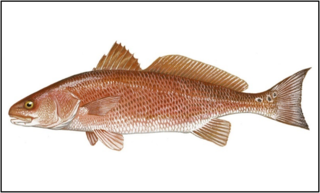
The red drum, also known as redfish, channel bass, puppy drum, spottail bass, or simply red, is a game fish found in the Atlantic Ocean from Massachusetts to Florida and in the Gulf of Mexico from Florida to northern Mexico. It is the only species in the genus Sciaenops.
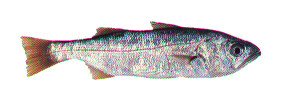
The queenfish is a species of fish in the family Sciaenidae, the drums and croakers. It is native to the eastern Pacific Ocean, where it occurs along the North American coastline from Oregon to Baja California; it has been recorded as far north as British Columbia. Its centre of distribution is the Southern California Bight. It is also known commonly as the queen croaker. This is the only species in the monotypic genus Seriphus.

The Atlantic croaker is a species of marine ray-finned fish belonging to the family Sciaenidae and is closely related to the black drum, the silver perch, the spot croaker, the red drum, the spotted seatrout, and the weakfish. It is commonly found in sounds and estuaries from Massachusetts to the Gulf of Mexico.

Isotria medeoloides, commonly known as small whorled pogonia or little five leaves, is a terrestrial orchid found in temperate Eastern North America.

The black drum, also known as the drum or drummer, is a species of marine ray-finned fish belonging to the family Sciaenidae, the drums and croakers. It is found in the western North Atlantic Ocean off the eastern coast of North America. Though most specimens are generally found in the 5-30 lb (2–14 kg) range, the largest black drum was just over 113 lb (51 kg). They are often black and/or gray in color with juvenile fish having distinctive dark stripes over a gray body. Their teeth are rounded and they have powerful jaws capable of crushing oysters and other shellfish. Black drum are capable of producing tones between 100 Hz and 500 Hz when performing mating calls.

Pogonias is a genus of ray-finned fish in the family Sciaenidae. It was formerly believed to be a monotypic genus only containing the black drum, but a second species was re-described in 2019.

The crested mona monkey, also known as the crowned guenon, crowned monkey, golden-bellied guenon, or golden-bellied monkey,, is a species of African primate in the family Cercopithecidae found in west central Africa.
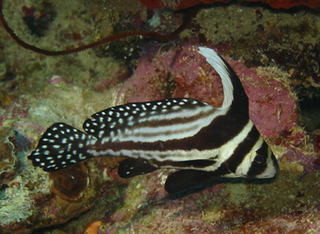
The spotted drum or spotted ribbonfish, is a species of marine ray-finned fish belonging to the family Sciaenidae, the drums and croakers. This species is found in the western Atlantic Ocean.

Pogonia ophioglossoides, the snakemouth orchid or rose pogonia, is a species of orchid occurring from central Canada to the east-central and eastern United States. It is the type species of the genus Pogonia. It is pollinated by bees. This species occurs in wet habitats. In the north, the habitat is typically fens but sometimes also bogs. Further south, along the Gulf Coast, it is a species of wet pine savannas and flatwoods.
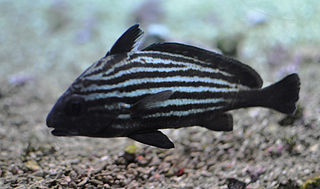
Pareques acuminatus, commonly known as the high-hat, donkeyfish, cubbyu, Steindachner's ribbonfish, streaked ribbonfish, striped ribbonfish or striped drum, is a species of marine ray-finned fish belonging to the genus Pareques in the family Sciaenidae, the drums and croakers. This species is found in the western Atlantic Ocean.

The brown meagre or corb is a species of marine ray-finned fish belonging to the family Sciaenidae, the drums and croakers. This species found in, the eastern Atlantic, Mediterranean Sea and Black Sea occurring in shallow waters and sandy bottoms. It is harvested for human consumption, especially in the Mediterranean.

The goatee croaker is a species of marine ray-finned fish belonging to the family Sciaenidae, the drums and croakers. It is the only species in the monospecific genus Dendrophysa. This species is found in the Indian Ocean and western Pacific Ocean along the coasts of southern and southeast Asia.
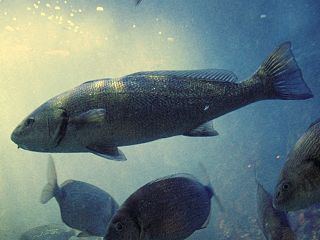
Umbrina cirrosa, the shi drum, is a species of marine fish from the warmer waters of the eastern Atlantic Ocean, Mediterranean Sea and the Black Sea. It is a commercially important species which is trawled for and farmed in aquaculture, as well as being a species pursued by anglers and spear fishermen for sport. The alternative vernacular names are gurbell, sea crow, bearded umbrine and corb.

The blackbar drum is a species of marine ray-finned fish belonging to the genus Pareques in the family Sciaenidae, the drums and croakers. It is found in the western Atlantic Ocean.

Foa's red colobus or the Central African red colobus, is a species of red colobus monkey found in the Democratic Republic of the Congo.

Oustalet's red colobus is a species of red colobus monkey. It lives in various types of forest in southern South Sudan, southern Central African Republic, northern Democratic Republic of the Congo and northeastern Republic of the Congo. It eats leaves, fruit, flowers, buds and possibly seeds. Males have a head and body length of between 45.9 and 68 cm with a tail length of between 55.5 and 73 cm. Females have a head and body length of between 52 and 64 cm with a tail length of between 68 and 73 cm. Males weigh about 12.5 kg (28 lb) and females weigh about 8.2 kg (18 lb).

Argyrosomus hololepidotus, also known as the Madagascar meagre or southern meagre, is a species of marine ray-finned fish belonging to the family Sciaenidae, the drums and croakers. The species is endemic to Madagascar and the Indian Ocean.
The Angola croaker is a species of marine ray-finned fish belonging to the family Sciaenidae, the drums and croakers. This is the only species in the monospecific genus Miracorvina. This fish is found in the eastern Atlantic Ocean from the Gulf of Guinea to southern Angola where it is found at depths between 50 and 300 m over sand and mud substrates in waters on the continental shelf and slope, staying deeper than the thermocline. It is a predator of nektonic fishes and crustaceans. This species has a maximum published total length of 120 cm (47 in) but 60 cm (24 in) is more typical. It is thought to be a rare species and is not targeted by fisheries.

















